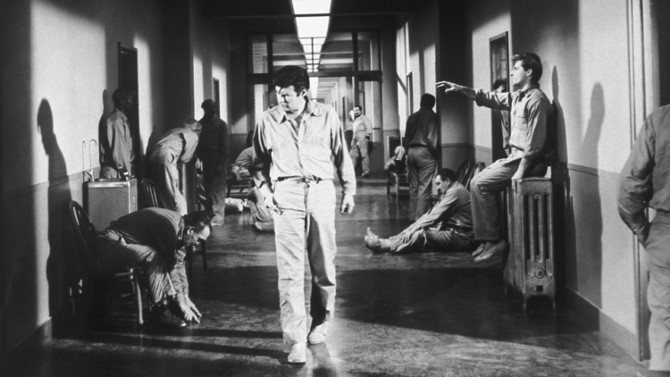10 days: that was how long it took to film the 1963 B-movie Shock Corridor. Originally advertized as an exploitation picture (and it does have some of those elements), Samuel Fuller’s film about a journalist who has himself committed to solve a mysterious murder is so much more than its original label.
Writer/director Fuller takes us on a rather unorthodox and nightmarish journey as we follow Johnny Barrett (Peter Breck – who looks like a cross between a young Roger Moore and Charlie Sheen), a cocky and overly driven journalist who works with an expert psychiatrist, his editor and his reluctant burlesque dancer girlfriend, Cathy (Constance Towers), to get committed in order to find out who murdered a patient in a mental institution. He believes that this will lead him to a Pulitzer Prize and to his rise as a well-known, celebrated scribe.
With the help of Cathy, Barrett convinces the doctors that he is infatuated with his sister (with his girlfriend playing this supposed sibling) and he enters the bizarre and stressful world – sharing a room with five other males – with one believing he is Pagliacci (Larry Tucker). His goal is to interview three unhinged individuals who were in the room when the murder was committed.
Fuller uses each of the three witnesses as a scathing critique of America at the time. The first man, Stuart (James Best), believes he is Confederate General J.E.B. Stuart, though we quickly realize that this is a cover for the complex emotions that the man is burying deep inside. We learn of the man’s xenophobic upbringing, his capture in Korea – which transformed him into a Communist, and his return home – which demonstrated the hatred Americans had towards his brief Leftist-leaning ways.
The second gent is named Trent (Hari Rhodes), an African-American man who was the first to enter University in the South when segregation was lifted. The man snapped from the pressure, and now believes he is a KKK white supremacist – a clear jab at the racism that was very present at this time in the United States and around the world.
Fuller gains enough information from these first two interviews to push forward with his investigation. His last hope for procuring the name of the murderer lies within atomic scientist Boden (Gene Evans) – who Fuller hopes will awaken from his current incarnation, that of a six year old child. The man, who has witnessed the insane power of weapons in modern warfare, has a clear focus on the nuclear anxiety of the Cold War era – and his regression to the mind set of a child is a clever choice.
As we watch Fuller push for this final piece of information, we can clearly see him struggle to stay sane in this claustrophobic world – with treatments performed on him by the doctors, further complicating his psyche. Will the journalist be able to figure out who committed the vile act and write the celebrity-making story, or will he crack under the pressure – staying ever more in the disorienting corridor of the insane asylum?
As you can probably imagine, with a short shoot such as this, there are a few issues with the film. At times, the story does not build enough suspense around the murder – though it is also clear that Fuller is using this storyline as a way to make his statement about 1960’s America. Plus, his visuals are quite striking. This film is a perfect example of the benefits of shooting in black and white – with shadow and light playing an intricate role in our viewing experience (sometimes focussing us on a character’s gaze or adding a layered effect that deepens our understanding of the situation). Fuller also uses visual techniques to create very memorable moments – with Cathy superimposed to the left of Barrett as he dreams about her (caressing his body while goading his psyche with the possibility that he could lose her). A nightmarish scene where rain pours down on Barrett in the corridor is not only an amazing piece of cinema – but also a way for Fuller, who filmed the shot last, to avoid having to do re-shoots for the ending – as he destroyed the set in the process. He also uses colour at three vital moments in the story – creating striking differences from the mostly black and white movie.
Fuller also adds in several nice touches of humour. Just one example is when a character screams insanely in the corridor and Pagliacci dryly mentions that he is out of key. There is also a rather funny nympo scene. The director also places a photo of himself in the dressing room of the striptease club – a nice touch which feels a little like an Alfred Hitchcock cameo.
Though Samuel Fuller is no longer a household name, his reach and influence cannot be understated. His visual-style of storytelling (which in part comes from his past as a newspaper writer and cartoonist) has influenced the likes of Martin Scorsese and Jim Jarmusch – to name but two modern filmmakers. You don’t have to be committed to enjoy this still very relevant flick.

